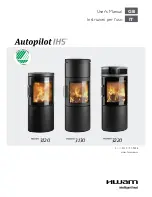
TLC 2000 Coal Stove
17
Venting to a Masonry Fireplace Chimney
In some situations, a code compliant chimney originally
used for a masonry fireplace may be used to install your TLC
000. In addition to the requirements found in the previous
paragraphs, it is important to be aware that all clearances
must be met, including those from the chimney connector to
combustibles — 18" (360 mm) to sides and 18" (450 mm)
to ceiling. Do not forget to include floor protection in your
plans. (See Clearances and Floor Protection in this section.)
Since many fireplaces have exposed wooden mantels and
trim, pay special attention to the clearances necessary to
these materials.
If your fireplace chimney is behind a combustible wall,
you must use an approved wall pass-through system to gain
access to the masonry chimney. The chimney connector must
enter the chimney at a place where it is lined, and the fireplace
must be made inoperable. For example, you might remove
the damper, replacing it with a secure, airtight, noncombus-
tible seal (removable for inspection); this also satisfies the
requirement that no room air must be allowed to enter the
chimney.
Do not connect this unit to a chimney flue
servicing another appliance.
NOTE: The restriction of not venting more than one ap
-
pliance to the same flue applies to the
U.S.
specifically. While
it is not recommended that you use the same chimney for
more than one appliance, in
Canada
certain exceptions may
be made. Be sure to contact your building code inspection
official to see if this option is allowed in your area, and to find
out the specific requirements for such an installation.
Existing Masonry Chimneys
If you plan on using a pre-existing masonry chimney, have
it thoroughly inspected and cleaned. Any faults which make
the chimney unsafe and unusable must be repaired prior to
use. These can include improper height, structural defects,
blockages, inadequate clearance to combustibles, unsealed
openings into other rooms of the house, signs of creosote or
smoke leakage, a loose or absent clean-out door, or absence
of a liner.
Do not connect to any air distribution
duct or system
Venting to a Masonry Chimney
When connecting to a masonry chimney, several provisions
are standard. First, whether the chimney connector is vented
to the chimney through a thimble or a breech pipe, neither
must pass beyond the inner surface of the chimney liner, and
both must be firmly cemented in place with refractory cement.
(A thimble is a masonry pipe which is inserted through the
chimney wall, and is frequently the preferred method; a breech
pipe is a piece of steel pipe used the same way.) In Canada,
a breech pipe has ridges or protrusions to lock it firmly into
the refractory cement. In either case, the chimney connector
vents to the chimney through the thimble or breech pipe.
Using a thimble, the connector slides completely inside the
masonry to the inner edge of the flue liner, and may be easily
removed for chimney and connector inspection. A breech
pipe must extend at least " (50 mm) into the room, so the
connector can be attached with sheetmetal screws.








































